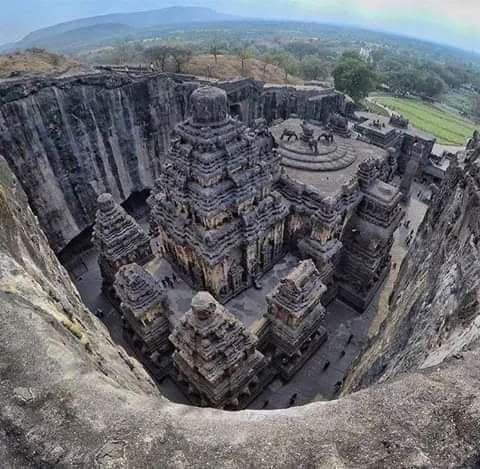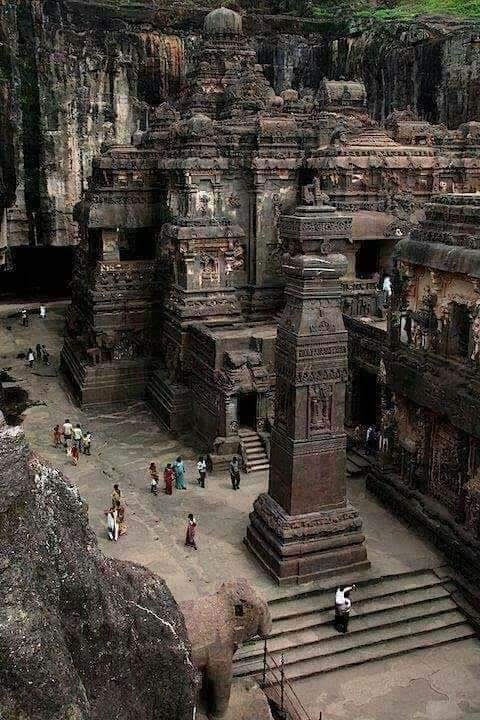AJANTA AND ELLORA CAVES
The Ajanta and Ellora caves are situated in the state of Maharashtra. These caves hold masterpieces of stone carvings and paintings of Hindu, Buddhist and Jain traditions. They also give us a glimpse of life of the inhabitants of the age during which the caves were constructed. Yes, constructed! These ‘caves’ were not natural caves but man-made ones for use by devotees and monks. They are also a testament to religious tolerance and harmony between these major religions of ancient India.

AJANTA CAVES:
Situated 106 km from Aurangabad in Maharashtra state, Ajanta has 29 caves, excavated along a rocky, horse-shoe shaped ravine. In 1983 this site was declared a World Heritage Site by UNESCO and, by any standards, the status is well-deserved. No well-rounded tour of India can be considered complete without a visit to Ajanta and Ellora.
The caves were constructed by adherents of Buddhism, and contain ‘viharas’ (monastic halls) and ‘chaitya grihas’ (stupa monument halls). Most of the caves were created during the Mahayana (later) phases of Buddhism but a few were excavated during the earlier (Hinayana) period. The viharas are of various sizes and often are square in shape. While scholars have debated the purpose of the viharas, the famous Chinese scholar Hsuan Tsang provided evidence that they were used as accommodations for teachers and students. Two Chaitya-grihas were found in caves 9 & 10 and three in caves 19, 26 and 29, repectively. The walls of Ajanta caves are adorned by exquisite paintings. Most of these depict Buddhist or Hindu subject matter. However, many depict themes from ordinary peoples’ lives.

These paintings are known for their artistic excellence. However, since the caves are poorly lit, having a portable source of light with the visitor is a necessity.
While complete details are not available, the process of painting involved two stages: First was roughening the surface of rock so it held the plaster. Then, the paint was applied, mixed with clay, linen, hay and dung. The colors were made from natural substances such as various stones, minerals and plants.
These caves also house numerous sculptural masterpieces, on the walls as well as on the ceilings, and as free-standing structures. Numerous beautifully sculpted pillars are

also present in these caves.
ELLORA CAVES:
Built between AD 600 and 1,000, there are 34 caves in all in this group. Ellora is 30 km from Aurangabad. Seventeen of these 34 caves were Hindu, 12 Buddhist and 5 Jain. The closeness of the caves is a testament to the religious tolerance practiced by the inhabitants of these caves. While all the caves have striking sculptures and are architecturally noteworthy, the absolute masterpiece is the Hindu temple in cave number 34 called Kailashnath temple. The structure is a temple carved out of one rock and is thus the largest monolithic structure in the world. The rest of this article will be devoted to this temple.
KAILASHNATH TEMPLE:


This structure is named after and shaped to represent Mt. Kailash, the abode of the Hindu god Shiva. It represents the finest example of Hindu rock art; it is stunning in architectural excellence as well as in the scale of construction. It was cut from one hill that was entirely made of granite, starting from the top and working their way down. This is in itself unusual. The structure is 1 1/2 times as tall as the Parthenon in Athens, and it covers twice as much area. Although exact figures are not known, it is believed to have taken 7,000 laborers, 150 years to complete; and 20,000 tons of rock were removed in the process. The walls and pillars of the structure are filled with scenes from the Hindu Epics Mahabharata and Ramayana. The quality of the sculpture is also exquisite. The temple itself has a gateway, antechamber, assembly hall, sanctuary and tower. The temple is 164 ft (50m) deep, 109 fit (33m) wide and 98 ft (30m) high.

Although all the caves in Ellora have examples of rock-cut art, in caves #30 there is a ‘chota’ (small) Kailashnath temple. The Kailashnath temple in cave 16 outshines every other structure in sheer beauty as well as in its size. Most visitors to Ellora come away awe-struck by this structure, and most believe that a visit to Ellora is not complete without a visit to this cave and the temple.